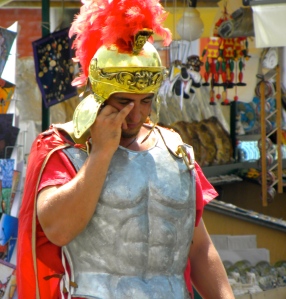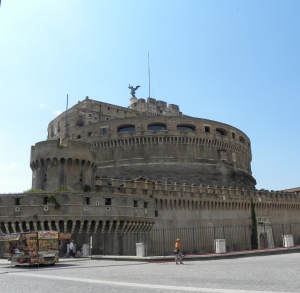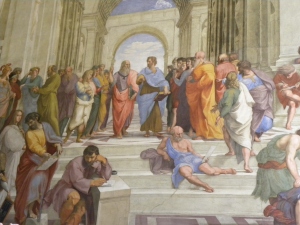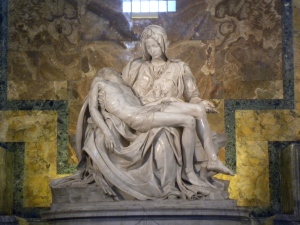Today we met our wonderful guide from Mirabilia Urbis Tours, Daniella Hunt, for a quick train ride to a great side-trip from Rome, the former seaport of Ostia Antica. I’ve posted a link to Daniella’s website, as well as a link to a website talking about Ostia. We choose Ostia for our one side-trip because we wanted to spend most of our week exploring the City, so didn’t want to travel as far as Pompeii or Florence — just too much time wasted in travel. Also, whereas Pompeii and Herculaneum were towns populated primarily by the wealthy and slaves, Ostia was a working waterfront with a full range of society. It also has a great bath to visit, and am amphitheater, a wine bar, apartments and villas — a great mix of things to see, and all extremely accessible (in fact, too much so, with not enough being protected from tourists and the elements… we walked over crumbling mosaics and it was such a shame that they couldn’t be protected by some clear material so you could see but not harm). So, Ostia it was. My 15-year-old daughter, who has minimal to no interest in history, was not pleased to be spending a day seeing “more old things”, in part because she thought 4 hours at the Palatine Hill/Forum/Colosseum was quite enough, thank you very much, so Daniella had her work cut out for her. My daughter ended up saying that her day in Ostia was her favorite day of the trip, so Daniella clearly did her job. On the train ride over Daniella showed us maps and information on what we’d be seeing, and starting telling us the story of the town, focusing on the role it played when the Roman empire was at its peak. My daughter started reading a book she’d brought alone during the first part of the story (and she doesn’t like to read, so she was trying to clearly show me how much she did not want to be there!) but after overhearing the stories for only a few minutes she forgot about the book and became in engrossed the tale of Ostia.
It’s a short train ride — we took a taxi to the Piramide Metro stop, which is the Roma Porta San Paolo train station, nd from there it was about 30 minute ride. The town itself is only a short walk once you depart the train. As soon as you enter through the Porta Romana you can see Sulla’s wall. Sulla played a large role in the first few books of Colleen McCullough’s series, so I felt as if I knew him. There isn’t much in Rome to see of Sulla, other than the Tabularium which he had built at the end of the Forum, and which you can pass through as part of the Capitoline Museums, so I was thrilled to touch the wall built by Sulla’s orders and through which he probably passed at least once.
(Pardon me as I digress on my Sulla sidetrack, all my comments about him being based on Colleen McCullough’s books and not through any independent research, and based on my recollection of reading those books earlier this year (so I may misremember, you need to read them yourself to be sure!) but I found him fascinating. He was from a poor but patrician family, and through luck, skill, ruthlessness or otherwise he was able to accumulate enough money to enter the Senate. Through his wartime exploits and his brilliant command of the legions he built quite a reputation for himself. He seems to have been handsome, ruthless, brilliant and persuasive, in some ways like Caesar. He ended up becoming dictator from 83-80 BCE before retiring to the countryside to enjoy his last days. I suggest you read more about him, as he truly is fascinating!)
We visited apartments to see where merchants lived above their shops, villas where the wealthy had their homes, the town’s forum, a wonderful example of a bath, a great public latrine as well as the fire station, which included the fireman’s latrine area complete with the god of bowel movements in the upper corner! There was also a wine bar where the bar area was still in tact as well as the outdoor dining area, and the area where they washed the dishes for the patrons to use. We spent a long time outside the amphitheater, where there are rows of little booths that were used by merchants or salesman to entice folks who had visited the amphitheater for a performance, to show of their wares. The various booths were marked by mosaics on the ground in front of them, advertising whatever it was that the person in that booth area had for sale or display. We spent all afternoon there before heading back home on the train (crowded on the way back with folks coming from a day at the beach from the new shoreline a few miles away, and then off for another night of dinner and gelato and piazzas and fountains before heading to bed.
We all felt as my daughter did, that this was one of our best days in Rome, so I highly recommend this sidetrip, especially for those who don’t make it to Pompeii or Herculaneum but even for those who do. We went to both the other towns a few months later and each of the three is unique and has things of value to see if you are interested in life in ancient rome. It really makes you realize that we aren’t so different than the folks who lived more than 2000 years ago, and to compare what their life was like with what life was like in the Americas during that time, or in England for that matter.
In addition to the links to the various websites, here are some photos we took of our day…








Here’s What Folks Are Saying…